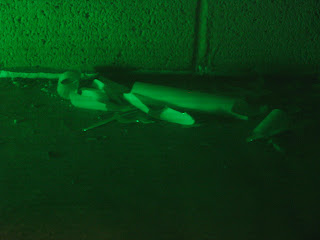
An oversized hose clamp seems to do the trick
Success...




Testing the acrylic dowels...

 I conducted several tests of the materials and process by stretching a piece of spandex fabric over the top of a 5 gallon pail. I then placed a piece of plywood across the top of the pail with two of the acrylic dowel form ties through it, supporting the fabric. The purpose of this test was to test if the spandex would contain the wet concrete mixture, how much the fabric would stretch, and if the acrylic dowel form tie system I developed would actually work.
I conducted several tests of the materials and process by stretching a piece of spandex fabric over the top of a 5 gallon pail. I then placed a piece of plywood across the top of the pail with two of the acrylic dowel form ties through it, supporting the fabric. The purpose of this test was to test if the spandex would contain the wet concrete mixture, how much the fabric would stretch, and if the acrylic dowel form tie system I developed would actually work.







 "Stepping over boundaries defines who we are." RI
"Stepping over boundaries defines who we are." RI He began to think of the context around the siting of his work (like an architect?), controlling gallery surfaces and lighting. He thought of the placement of his work with its context as an extension of the piece itself.
He began to think of the context around the siting of his work (like an architect?), controlling gallery surfaces and lighting. He thought of the placement of his work with its context as an extension of the piece itself.  Irwin joins prestegious FERUS gallery and jumps on the
Irwin joins prestegious FERUS gallery and jumps on theuntitled 1958
He begins to experiment with the relationship of the viewer and object; alter shapes of paintings; pay precise attention to their physical construction; and explore the painting as an object in space.
untitled 1958

While at the FERUS, Irwin was influenced by other artists:
Kraig Kauffman
Ed Moses
Bill Bengston
untitled 1958
